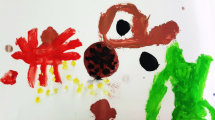Abstract
When the focus of the child treatment is on the therapist being a “good” object, this can accentuate a possible countertransference difficulty of the therapist becoming the protector of the child from the “bad” object. This countertransference can often resonate with rescue fantasies in the child. This paper will explore the topic of rescue fantasies in child treatment, while addressing the issue of coinciding fantasies existing unconsciously in both the therapist and child, leading to their enactment. A case of a nine-year old boy is presented which demonstrates how interpretation and resolution of rescue fantasies can lead to a deepening of the treatment.
Similar content being viewed by others
References
Anthony, E. J. (1986). The contributions of child psychoanalysis to psychoanalysis. Psychoanalytic Study of the Child, 41, 61–87.
Berman, E. (1997). Hitchcock's Vertigo: The collapse of a rescue fantasy. International Journal of Psychoanalysis, 78, 975–988.
Bernstein, I., & Glenn, J. (1978). The child analyst's emotional reactions to his patients. In J. Glenn (Ed.), Child Analysis and Therapy pp. 375–392. New York: Jason Aronson.
Bornstein, B. (1948). Emotional barriers in the understanding and treatment of children. American Journal of Orthopsychiatry, 18, 691–697.
Chused, J. F. (1988). Transference neurosis in child analysis. Psychoanalytic Study of the Child, 43, 51–81.
Chused, J. F. (1991). The evocative power of enactments. Journal of the American Psychoanalytic Association, 39, 615–639.
Chused, J. F. (1997). Discussion of ''Observing-participation, mutual enactment, and the new classical models'' by Irwin Hirsch. Contemporary Psychoanalysis, 33, 263–277.
Deutsch, H. (1945). The Psychology of Women. New York: Grune and Stratton.
Esman, A. H. (1987). Rescue Fantasies. Psychoanalytic Quarterly, 56, 263–270.
Frankiel, R. (1985). The stolen child: A fantasy,a wish, a source of countertransference. International Review of Psychoanalysis, 12, 417–430.
Ferenczi, S. (1919). On the technique of psychoanalysis. In Further Contributions to the Theory and Technique of Psychoanalysis. New York: Brunner-Mazel, 1980, pp. 177–189.
Freud, A. (1936). The Ego and the Mechanisms of Defense. New York: International University Press.
Freud, S. (1986). Family Romance. In J. Strachey (Ed. and trans.), The Standard Edition of the Complete Psychological Works of Sigmund Freud (Vol. 10, pp. 74–78). London: Hogarth Press. (Original work published 1909)
Freud, S. (1986). A special type of object choice made by men. In J. Strachey (Ed. and trans.), The Standard Edition of the Complete Psychological Works of Sigmund Freud (Vol. 11, pp. 43–61). London: Hogarth Press. (Original work published 1910)
Frosch, J. (1959). Transference derivatives of the family romance. Journal of the American Psychoanalytic Association, 7, 503–522.
Gillman, R. (1992). Rescue fantasies and the secret benefactor. Psychoanalytic Study of the Child, 47, 279–298.
Glenn, J., Sabot, L. M., & Bernstein, I. (1978). The role of the parents in child analysis. In J. Glenn (Ed.), Child Analysis and Therapy, (pp. 393–426.) New York: Jason Aronson.
Greenacre, P. (1966a). Emotional Growth. New York: International University Press.
Greenacre, P. (1966b). Problems of overidealization of the analyst and of analysis. In Emotional Growth Vol. 11 (pp. 743–761). New York: International Universities Press, 1971.
Grinstein, A. (1957). A specific defense in psychoanalytic therapy: ''Comes the knight in shining armor''. Journal of the American Psychoanalytic Association, 5, 124–129.
Jacobs, T. (1986). On countertransference enactments. Journal of the American Psychoanalytic, 34, 289–308.
Joseph, B. (1985). Transference: The total situation. International Journal of Psychoanalysis, 66, 447–454.
Kabcenell, R. (1974). On countertransference. Psychoanalytic Study of the Child, 29, 27–35.
Norman, J. (1989). The analyst's visual images and the child analyst's trap. Psychoanalytic Study of the Child, 44, 117–135.
Sanville, J. (1991). The Playground of Psychoanalytic Therapy. New Jersey: The Analytic Press.
Sterba, R. (1940). Aggression in the rescue fantasy. Psychoanalytic Quarterly, 9, 505–508.
Volkan, V. D. (1985). Becoming a psychoanalyst. In J. Reppen (Ed.) Analysts at Work (pp. 215–231). New Jersey: Analytic Press.
Author information
Authors and Affiliations
Rights and permissions
About this article
Cite this article
Malawista, K.L. Rescue Fantasies in Child Therapy: Countertransference/Transference Enactments. Child and Adolescent Social Work Journal 21, 373–386 (2004). https://doi.org/10.1023/B:CASW.0000035222.16367.32
Issue Date:
DOI: https://doi.org/10.1023/B:CASW.0000035222.16367.32




